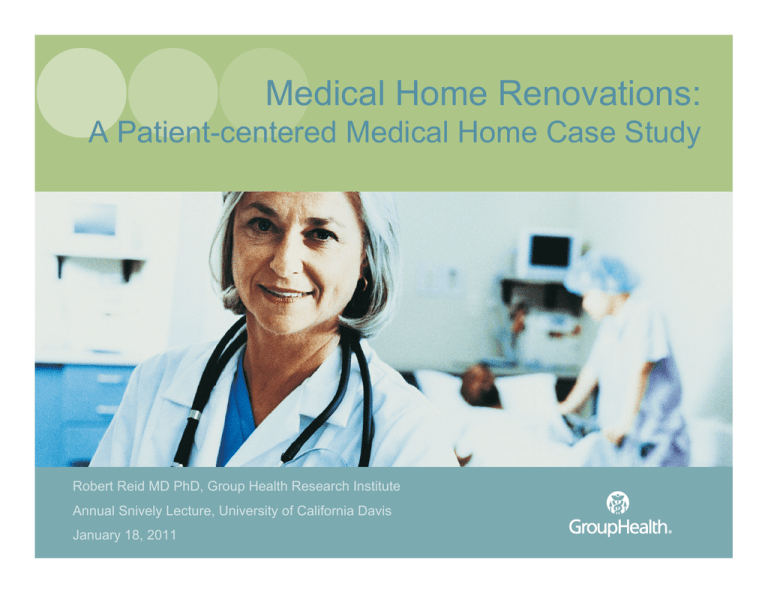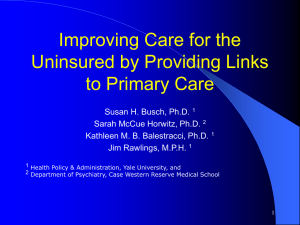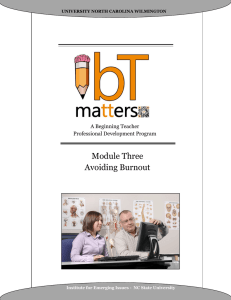Medical Home Renovations: A Patient-centered Medical Home Case Study
advertisement

Medical Home Renovations: A Patient-centered Medical Home Case Study Robert Reid MD PhD, Group Health Research Institute Annual Snively Lecture, University of California Davis January 18, 2011 Medical Home Renovations… • Revitalizing primary care: the medical home imperative • The Patient-centered Medical Home: An Evolving Definition • Medical Home Transformation: the Group Health Experience • Spreading the Medical Home using Lean The burning platform of primary care Access to primary difficult for many, particularly disadvantaged Quality of remains mediocre with many gaps Payment systems are antiquated. Many functions are unrewarded Evidence-base has become unmanageable for individual physicians Primary care is an unattractive career choice. Burnout common Medical Home: a Concept in Evolution Joint Principles of Patient-Centered Medical Home 2007 (ACP, AAFP, AAP, AOA) 1. Personal physician 2. Physician directed medical practice 3. Whole person oriented 4. Care is integrated & coordinated 5. Assures quality & safety 6. Enhanced access 7. Payment Reform Medical Home: a Concept in Evolution Reinvigorating Core Attributes of Primary Care (access, longitudinal relationships, comprehensiveness, coordination) System supports for Chronic Illness Care & Prevention (info systems, practice redesign, self mgmt support, decision support) Advanced information technologies (EMRs, registries, reminders, patient portals) Supportive physician payment methods (promotes medical home goals, not simply volume) The Chronic Care Model (CCM) Health System Community Resources and Policies SelfManagement Support Informed, Activated Patient Health Care Organization Delivery System Design Productive Interactions Decision Support Clinical Information Systems Prepared, Proactive Practice Team Improved Outcomes (Wagner EH et al, Managed Care Quarterly, 1999. 7(3) 56-66) 6 Group Health’s Medical Home Experiment About Group Health… •Integrated health insurance & delivery system •Founded in 1946 •Consumer governed, non-profit •Membership: 628,000 Staff: 9,390 •Revenues (2008): $2.8 billion •Integrated Group Practice •Multispecialty Group Practice •• 26 26 primary primary care care medical medical centers centers •• 6 1 hospital 6 specialty specialty systems, units, 1 maternity hospital •~900 physicians • 960 physicians •Contracted •Contracted network network •> • >9,000 9,000pracititioners, practitioners, 39 39 hospitals hospitals •Group Health Research Institute •32 investigators •235 active grants, $34 million (2008) A little history…. • Since its origin, Group Health organized around primary care Defined practice populations Specialty care gatekeeping Multi-disciplinary teams Salaried physicians • In 2000s multiple reforms to improve access, efficiency, productivity “Advanced access” Same-day appointing Leaner primary care teams Direct specialty access RVU-based productivity incentives • $40 million invested in electronic clinical information systems System-wide EMR Patient portal with secure messaging & lab results access Decision support tools, reminders & alerts (Ralston et al, Med Care Res Rev. 2009;66:703-24.) The medical home imperative Utilization Trends 1997-2005 by Quarter 0.9 Access & Efficiency Reforms 0.8 0.7 Frequency 0.6 Primary Care Visits Primary Care Visits 0.5 Specialty Care Visits Specialist Visits Inpatient Days Inpatient Admits 0.4 Emergency Department 0.3 0.2 Inpatient Days ER Visits Inpatient Admits 0.1 0 1997 1998 1999 2000 2001 2002 2003 2004 2005 The medical home imperative Inpatient & ER Utilization Trends 1997-2005 by Quarter 0.09 Access & Efficiency Reforms 0.08 Inp at ient Days 0.07 Inp at ient A d mit s Emerg ency Dep art ment Frequency Frequency 0.06 ER Visits 0.05 Inpatient Days 0.04 0.03 0.02 0.01 Inpatient Admits 0 1997 1998 1999 2000 2001 2002 2003 2004 2005 The medical home imperative Increasing primary care physician burnout “...the way in which [care] is structured, it has shifted such an increased amount of work onto primary care that it is not sustainable … I’m actually looking to get out of primary care because I can no longer work at this pace.” “ The burnout rate among my colleagues is huge … those of us that have managed to retain some semblance of balance do it by almost unacceptable levels of compromise, either for ourselves or what we define as good enough care.” (Tufano et al, JGIM 2008;23:1778-83) Looming primary care workforce crisis • Many MD positions remained unfilled • Shift to part-time practice • Primary care MDs retiring earlier than specialists • Most common reason for employment separation: high workload The medical home imperative There has to be a better way! Medical Home Design Principles (2006) relationship between the primary care clinician & patient is at ✔ The our core; the entire delivery system will orient to promote & sustain. ✔ The primary care clinician will be a leader of the clinical team, responsible for coordination of services, and together with patients will create collaborative care plans. ✔ will be centered on patients needs, be available by various ✔ Access modes, and maximize the use of technology. Care will be proactive and comprehensive. Patients will be actively informed and encouraged to participate. ✔ Our clinical and business systems are aligned to achieve the most efficient, satisfying and effective experiences. Revitalizing primary care Panel size PCMH design: Clinical teams 2,300 1,800 Appointments 30 min. 20 min. Desktop time E-technology 15 Medical home change components PCMH Model Point-of-care changes • Calls redirected to care teams • Secure e-mail • Phone encounters • Pre-visit chart review • Collaborative care plans • EHR best practice alerts • EHR prevention reminders • Defined team roles Patient-centered outreach • ED & urgent care visits • Hospital discharges • Quality deficiency reports • e-health risk assessment • Birthday reminder letters • Medication management • New patients Management & payment • Team huddles • Visual display systems • PDCA improvement cycles • Salary only MD compensation Medical home pilot evaluation Group Health Research Institute conducted a 2 yr prospective, before-and-after evaluation comparing the pilot with 19 other Group Health clinics in western Washington State Medical home pilot evaluation Evaluation measures: Patient experience Staff burnout Quality Utilization Cost Reid RJ et al, Health Affairs 2010;29(5):835-43 Larson EB et al, JAMA 2010; 306(16):1644-45 Reid RJ et al, Am J Manag Care 2009;15(9):e71-87 19 Selected change components Year 1: 94% more emails, 12% more phone consultations, 10% fewer calls to consulting nurse Year 2: Significant changes persisted Year 1 Year 2 Secure email messages Telephone encounters Consulting nurse calls Compared to controls: Medical Home significantly higher Medical Home significantly lower Difference not significant 20 Patient experience Significantly higher scores for patients at Medical Home Clinic Year 1 Year 2 Quality of patient-doctor interactions Shared decision making Coordination of care Access Helpfulness of office staff Patient activation/involvement Goal setting/tailoring Compared to controls: Medical Home significantly higher Medical Home significantly lower Difference not significant 21 Quality of care Composite quality gains significantly greater for patients at Medical Home clinic across 22 indicators Mean difference of changes between pilot and control clinics Year 1 Year 2 100% performance 75% performance 50% performance Compared to controls: Medical Home significantly higher Medical Home significantly lower Difference not significant 22 Staff burnout Year 1: Marked improvement in burnout levels at Medical Home Year 2: Continued better scores at Medical Home; controls slightly worse Year 1 Year 2 Emotional exhaustion Depersonalization Lack of personal accomplishment Compared to controls: Medical Home significantly higher Medical Home significantly lower Difference not significant 23 Utilization Year 1: 29% fewer ER visits, 11% fewer preventable hospitalizations, 6% fewer but longer in-person visits Year 2: Significant changes persisted Year 1 Year 2 Primary care visits (in person) Emergency/urgent care use Preventable hospitalizations Total hospitalizations Compared to controls: Medical Home significantly higher Medical Home significantly lower Difference not significant 24 Costs Year 1: No significant difference in total costs between Medical Home and control clinics. Year 2: Significant utilization changes persisted. Lower patient care costs approached stat significance (~$10 PMPM; p=0.08) Year 1 Year 2 Primary care costs Emergency/urgent care costs Hospitalization costs Total PMPM Compared to controls: 25 Medical Home significantly higher Medical Home significantly lower Difference not significant 25 Our learnings so far It is possible to improve outcomes, lessen burnout, and reduce costs but: Investments in primary care are critical Requires fundamental change that is not easy. Physicians & care teams need to “own” the changes Including patient voices helps ground your efforts IT must be embedded in team workflows Capable & aggressive management Our learnings so far Financing: investments made need to align with savings recouped Reimbursement: payments need to reward medical home activities & outcomes, not just volume Education: new skills needed (team work, quality improvement, behavioral medicine, virtual medicine) IT: meaningful use needs to incorporate patient perspectives Spreading the Medical Home: Linking the Pilot Design to Lean Spreading the Medical Home Based on pilot results, Group Health decided to invest $40 million and “spread” the medical home to 25 other clinics. But new questions emerged: What were the key components of the redesign? Can they be generalized? Can similar benefits accrue when clinics don’t invent the work? What techniques & tools should we use to spread? How Was Medical Home Spread? Design Process •RPIW’s •Dissected pilot experience •Designed standard work by engaging frontline teams Spread Pilot •Testing and improving the standard work elements at 3 other clinics •Learning best practices to help future clinics with spread Spread •Each element rolled out across clinics (10 wks) •Each element implemented before the next started 30 Spreading the medical home 1. Staged spread of practice change modules Virtual Medicine Care Management Visit Preparation Patient Outreach 2. Supported by changes to mgmt, staffing, & MD payment Call Management Team Huddles Enhanced Staffing Model Standard Mgmt Practices Value-based MD Payment Model Standardization & Spread using LEAN Techniques & Tools MORE TIME Phone, Secured Messaging e.g. 1,800 MORE TIME In Process Measures by clinic and element By element By clinic 33 33 Studying the Medical Home Spread AHRQ R18 Grant – Mixed Methods Evaluation Quantitative Component 60 month interrupted time series design Effect of PCMH transformation on cost, quality & staffing Qualitative Study Staff & leader interviews, direct observation & patient focus groups Organizational & contextual effects on PCMH transformation Effect of PCMH transformation on patient experiences Thank you!! Rob Reid reid.rj@ghc.org




